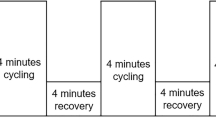Abstract
Purpose
This study aimed at testing the hypothesis that positive cardiolocomotor coordination (CLC) measure occurs by chance during a running task where the heart rate (HR) is approximated to the step frequency (StepF).
Methods
The electrocardiogram and electromyogram from the right gastrocnemius lateralis muscle were continuously recorded from ten healthy young men running at a paced rhythm of 152 step/min, to monitor HR and StepF. CLC was evaluated by phase synchrograms and the index of conditional probability (iCP). Results were validated with surrogate data and a crossover approach, where the HR of one subject was related to the StepF of another one, and comparisons were made combining subjects two by two.
Results
Six subjects showed synchrogram structures and high iCP values (≥0.8), suggesting the occurrence of physiological entrainment, when the HR reached the SF range. In crossover analysis, phase synchrograms and iCP presented similar behavior of original data when the HR from one subject was close enough to the SF from another one. Significant iCP values in 46 of 90 comparisons (51%) were observed, including all cases crossing signals among the six positive cases.
Conclusion
Synchrogram and iCP tools currently employed for measuring CLC are not appropriate because they indicate the occurrence of this phenomenon even among subjects who ran on different days and times of each other.



Similar content being viewed by others
Abbreviations
- \(\phi_{r,l}\) :
-
Relative phase
- CLC:
-
Cardiolocomotor coordination
- ECG:
-
Electrocardiogram
- EMG:
-
Electromyogram
- EMGenv:
-
EMG envelope
- HR:
-
Heart rate
- iCP:
-
Index of conditional probability
- RC:
-
Running cycle
- SF:
-
Stride frequency
- StepF:
-
Step frequency corresponds to twice SF
References
Bahraminasab A, Kenwright D, Stefanovska A, Ghasemi F, McClintock PV (2008) Phase coupling in the cardiorespiratory interaction. IET Syst Biol 2(1):48–54
Ekblom B, Goldbarg AN, Kilbom A, Astrand PO (1972) Effect of atropine and propranolol on the oxygen transport system during exercise in man. Scan J Clin Lab Invest 30:35–42
Glass L (2001) Synchronization and rhythmic processes in physiology. Nature 410(6825):277–284
Hermens HJ, Freriks B, Disselhorst-Klug C, Rau G (2000) Development of recommendations for SEMG sensors and sensor placement procedures. J Electromyogr Kinesiol 10(5):361–374
Hodges PW, Bui BH (1996) A comparison of computer-based methods for the determination of onset of muscle contraction using electromyography. Electroencephalogr Clin Neurophysiol 101(6):511–519
Kirby RL (1992) The cardiac-locomotor coupling phenomenon: the contribution of Coleman. Percept Mot Skills 74(2):489–490
Kirby RL, Nugent ST, Marlow RW, MacLeod DA, Marble AE (1989) Coupling of cardiac and locomotor rhythms. J Appl Physiol 66(1):323–329
Kirby RL, Atkinson SM, Donville JE, Urdang MF, Stanley DA, Gupta SK, Macleod DA (1992) Failure of accentuated vertical body movements to induce cardiac-locomotor coupling. J Appl Physiol 72(4):1368–1374
Materko W, Nadal J, Miranda de Sá AMFL (2015) Investigating cardiolocomotor synchronization during running in trained and untrained males. Res Biomed Eng 31(2):176–186
Meardon SA, Hamill J, Derrick TR (2011) Running injury and stride time variability over a prolonged run. Gait Posture 33(1):36–40
Mello RG, Oliveira LF, Nadal J (2007) Digital Butterworth filter for subtracting noise from low magnitude surface electromyogram. Comput Methods Programs Biomed 87(1):28–35
Nakayama Y, Kudo K, Ohtsuki T (2010) Variability and fluctuation in running gait cycle of trained runners and non-runners. Gait Posture 31(3):331–335
Niizeki K, Kawahara K, Miyamoto Y (1993) Interaction among cardiac, respiratory, and locomotor rhythms during cardiolocomotor synchronization. J Appl Physiol 75(4):1815–1821
Nomura K, Takei Y, Yanagida Y (2001) Analysing entrainment of cardiac and locomotor rhythms in humans using the surrogate data technique. Eur J Appl Physiol 84(5):373–378
Nomura K, Takei Y, Yanagida Y (2003) Comparison of cardio-locomotor synchronization during running and cycling. Eur J Appl Physiol 89(3–4):221–229
Nomura K, Takei Y, Yoshida M, Yanagida Y (2006) Phase-dependent chronotropic response of the heart during running in humans. Eur J Appl Physiol 97(2):240–247
O’Rourke M, Avolio A (1992) Improved cardiovascular performance with optimal entrainment between heart rate and step rate during running in humans. Coron Artery Dis 3(9):863–869
Palus M (1997) Detecting phase synchronization in noisy systems. Phys Lett A 235:341–351
Palus M, Hoyer D (1998) Detecting nonlinearity and phase synchronization with surrogate data. IEEE Eng Med Biol Mag 17(6):40–45
Porta A, Montano N, Furlan R, Cogliati C, Guzzetti S, Gnecchi-Ruscone T, Malliani A, Chang HS, Staras K, Gilbey MP (2004) Automatic classification of interference patterns in driven event series: application to single sympathetic neuron discharge forced by mechanical ventilation. Biol Cybern 91(4):258–273
Rosenblum M, Pikovsky A (2003) Synchronization: from pendulum clocks to chaotic lasers and chemical oscillators. Contemp Phys 44(5):401–416
Schäfer C, Rosenblum M, Kurths J, Hans-Henning A (1998) Heartbeat synchronized with ventilation. Nature 392(6673):239–240
Stefanovska A, Haken H, Mcclintock PVE, Hožič M, Bajrović F, Ribarič S (2000) Reversible transitions between synchronization states of the cardiorespiratory system. Phys Rev Lett 85(22):4831–4834
Tass P, Rosenblum MG, Weule J, Kurths J, Pikovsky A, Volkmann J, Schnitzler A, Freund HJ (1998) Detection of n:m phase locking from noisy data: application to magnetoencephalography. Phys Rev Lett 81(15):3291–3294
Toledo E, Akselrod S, Pinhas I, Aravot D (2002) Does synchronization reflect a true interaction in the cardiorespiratory system? Med Eng Phys 24(1):45–52
Acknowledgements
This study was partially supported by the Brazilian Research Council (student and research fellowship) and CAPES Foundation/Brazilian Ministry of Education (research Grant and student fellowship).
Author information
Authors and Affiliations
Corresponding author
Ethics declarations
Ethical approval
All procedures performed in studies involving human participants were in accordance with the ethical standards of the institutional and/or national research committee and with the 1964 Helsinki Declaration and its later amendments or comparable ethical standards.
Informed consent
Informed consent was obtained from all individual participants included in the study.
Conflict of interest
There are no conflict of interest.
Additional information
Communicated by Massimo Pagani.
Rights and permissions
About this article
Cite this article
Cerqueira, L.S., D’Affonsêca Netto, A., Mello, R.G.T. et al. Crossover assessment of cardiolocomotor synchronization during running. Eur J Appl Physiol 117, 315–322 (2017). https://doi.org/10.1007/s00421-016-3513-9
Received:
Accepted:
Published:
Issue Date:
DOI: https://doi.org/10.1007/s00421-016-3513-9




